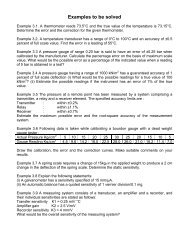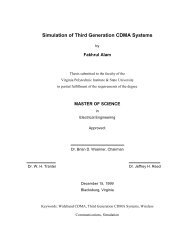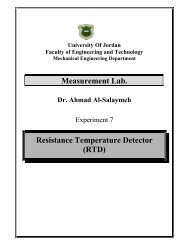Communications I Dr. Mohammed Hawa Introduction to Digital - FET
Communications I Dr. Mohammed Hawa Introduction to Digital - FET
Communications I Dr. Mohammed Hawa Introduction to Digital - FET
You also want an ePaper? Increase the reach of your titles
YUMPU automatically turns print PDFs into web optimized ePapers that Google loves.
impulses, as shown in Figure 4 below 4 . We will explain in class the differencebetween practically-sampled signals, naturally-sampled signals, and ideally-sampledsignals.Samples Values Sampled Signal, m s (t)m ptT sSampling Time-m pT sFigure 4. Practical Sampling.II. Quantization:The next step in analog-<strong>to</strong>-digital conversion is Quantization, which limits the digitaldata <strong>to</strong> be sent. Quantization is the process in which each sample value isapproximated or “limited <strong>to</strong>” a relatively-small set of discrete quantization levels. Forexample, in uniform quantization if the amplitude of the signal m(t) lies in the range(-mp, mp), we can partition this continuous range in<strong>to</strong> L discrete intervals, each oflength v = 2 mp /L, and the value of each sample is then approximated <strong>to</strong> only oneof these L levels.Notice that quantization can be done in several different ways. In one method thevalue of each sample can be “truncated” <strong>to</strong> the quantization level just below it. Thisis shown in Figure 5 below for L = 5 levels.Sample Values now Quantizedm pm(t)errorQuantization Error = m s(t) – m sq(t) = [0, v]-m pFigure 5.m sq(t)vtL = 5Levels,Rule =Truncate4 Typical IC-based ADC chips perform sampling, quantization and mapping all on the same chip.4
















